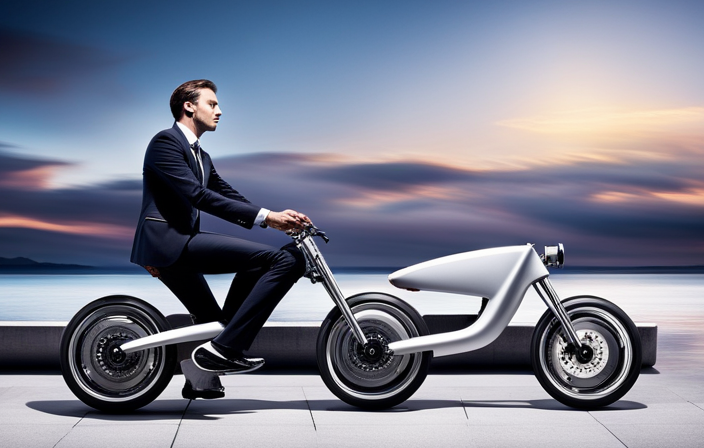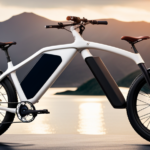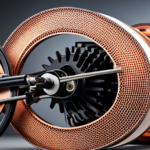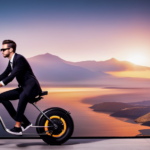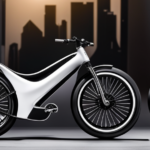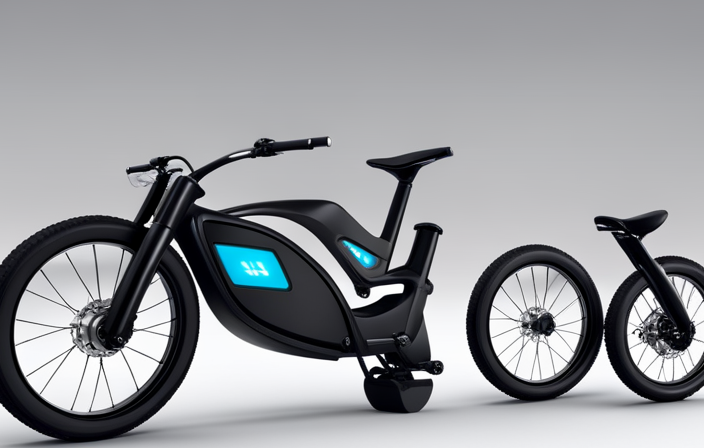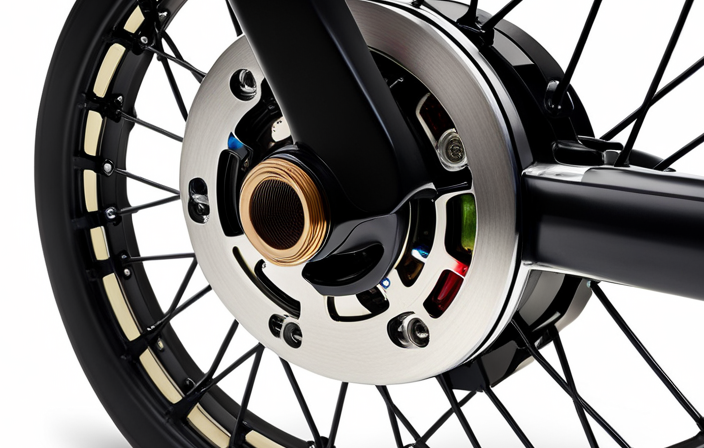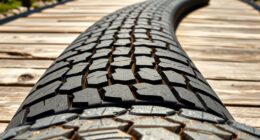As the saying goes, knowledge is power, and when it comes to electric bikes, understanding their power consumption is crucial. If you’re curious about how many watts an electric bike uses, you’ve come to the right place.
In this article, we’ll delve into the intricate world of electric bike power, exploring factors that affect wattage, different motor types and their requirements, battery capacity’s impact, power modes, terrain considerations, maintenance tips, and even future trends in this technology.
So, let’s dive in and unlock the secrets of electric bike power consumption.
Key Takeaways
- Factors affecting electric bike wattage include speed, rider weight, terrain, battery capacity, and motor design.
- Different types of electric bike motors have varying power requirements, such as hub motors, mid-drive motors, and friction drive motors.
- Battery capacity plays a significant role in power usage, with higher capacity batteries delivering more power to the motor but also resulting in longer charging times.
- Electric bike power modes, including eco, normal, and boost, allow riders to customize their riding experience and balance between energy saving and maximum power output.
Understanding Electric Bike Power Consumption
An electric bike typically uses around 250 watts of power. This power output refers to the amount of energy consumed by the electric motor while the bike is in operation.
Electric bike power consumption is determined by various factors, including the speed at which the bike is traveling, the weight of the rider, and the terrain being traversed.
When an electric bike is traveling at a higher speed or climbing a steep hill, it requires more power to maintain the desired level of performance. On the other hand, when the bike is traveling on flat ground or the rider is pedaling, the power consumption is lower.
Understanding these factors affecting electric bike wattage is crucial in optimizing the bike’s performance and ensuring efficient energy usage.
Factors Affecting Electric Bike Wattage
One factor affecting the wattage of an e-bike is its battery capacity. The larger the battery capacity, the more power it can provide to the electric motor, resulting in higher wattage.
Another factor that influences electric bike power efficiency is the motor’s design. Brushless motors are generally more efficient than brushed motors, which means they require less wattage for the same level of performance.
Additionally, the weight of the rider can impact the wattage of an electric bike. Heavier riders require more power from the motor to maintain the same speed as lighter riders. Therefore, the wattage needed to propel an electric bike can vary depending on the weight of the rider.
Moving forward to the subsequent section about ‘types of electric bike motors and their power requirements,’ it is important to understand the various factors that affect the wattage of an electric bike.
Types of Electric Bike Motors and their Power Requirements
The types of e-bike motors and their power requirements vary based on their design and specifications. There are three main types of electric bike motors: hub motors, mid-drive motors, and friction drive motors.
Hub motors are the most common type and are typically found in the front or rear wheel. They come in various power options ranging from 250 watts to 1000 watts or more.
Mid-drive motors, on the other hand, are located near the crankset and provide a more balanced and efficient riding experience. They generally have higher power requirements, often ranging from 500 watts to 1500 watts.
Lastly, friction drive motors use a roller that comes into contact with the tire, offering a simpler and lighter motor option. Their power requirements can vary depending on the specific model.
Understanding the different electric bike motor types and their power requirements is crucial in choosing the right e-bike for your needs. Moving on to battery capacity and its impact on power usage…
Battery Capacity and its Impact on Power Usage
To maximize your riding time, you’ll want to consider the battery capacity and how it affects your power usage.
The battery capacity of an electric bike refers to the amount of energy it can store. A higher battery capacity means a longer battery life, allowing you to ride for extended periods before needing to recharge. On the other hand, a lower battery capacity will limit your riding time and require more frequent charging.
Additionally, the battery capacity also affects the power usage of your electric bike. A higher capacity battery can deliver more power to the motor, allowing for faster acceleration and higher top speeds. However, it’s important to note that a larger battery capacity also means longer charging times. Therefore, it’s crucial to strike a balance between battery capacity and your specific riding needs.
This brings us to the next section about electric bike power modes: eco, normal, and boost.
Electric Bike Power Modes: Eco, Normal, and Boost
The different power modes available on electric bikes are eco, normal, and boost, allowing riders to customize their riding experience.
In eco mode, the electric bike uses the least amount of power, focusing on energy saving. This mode is perfect for long rides where conserving battery life is crucial.
The normal mode is the standard power mode, offering a good balance between power and efficiency. It provides a decent level of assistance without draining the battery too quickly.
On the other hand, boost mode, also known as turbo mode, delivers maximum power output. This mode is ideal for tackling steep hills or when you need an extra burst of speed.
With these power modes, electric bike riders can select the level of assistance that suits their needs.
Transitioning into the subsequent section about estimating electric bike range based on wattage, let’s now discuss how the power mode selection affects the overall distance you can ride on a single charge.
Estimating Electric Bike Range based on Wattage
Estimating your electric bike’s range based on wattage can help you plan your rides more effectively. Understanding how different terrains and power modes can affect your electric bike’s battery life is crucial in estimating its range. Here are some factors to consider:
-
Terrain: Uphill rides require more power and can significantly reduce your bike’s range. On the other hand, riding on flat or downhill terrains will conserve more battery life.
-
Power Mode: Riding in eco mode consumes less wattage and extends your bike’s range. Normal mode uses a moderate amount of power, while boost mode drains the battery faster but provides a higher level of assistance.
-
Rider Weight: Heavier riders may experience a slight decrease in range compared to lighter riders.
-
Wind Resistance: Riding against strong winds can increase power consumption and reduce your bike’s range.
Estimating your electric bike’s range based on wattage and these factors will help you choose the best power mode and plan your rides accordingly.
Moving forward, let’s explore comparing wattage options for electric bikes.
Comparing Wattage Options for Electric Bikes
Comparing wattage options for e-bikes can help you choose the most suitable power level for your needs. When estimating power consumption, it is important to consider the wattage of the motor.
Higher wattage generally means more power, which can result in greater speed and uphill climbing ability. However, it also means higher power consumption and potentially reduced battery life.
Comparing motor efficiency is another crucial factor. A more efficient motor will convert a higher percentage of the energy from the battery into useful power, resulting in longer range and better overall performance.
By comparing wattage options and considering motor efficiency, you can find the right balance between power and energy consumption for your specific requirements. This will ensure that your electric bike meets your needs without compromising on performance.
Now let’s explore how to choose the right wattage for your electric bike.
How to Choose the Right Wattage for Your Electric Bike
To choose the right wattage for your e-bike, consider your specific needs and the terrain you will be riding on. Choosing a suitable power for your electric bike is crucial to ensure optimal performance and efficiency.
Higher wattage options offer several benefits, including increased speed and the ability to tackle steep hills and rough terrains with ease. With higher wattage, you can enjoy a more powerful and exhilarating ride. Additionally, electric bikes with higher wattage motors tend to have a greater range, allowing you to travel longer distances without needing to recharge.
However, it’s important to note that higher wattage options may also consume more battery power, so it’s essential to find the right balance. With the appropriate wattage, you can maximize your electric bike’s efficiency and enjoy a smooth and enjoyable ride.
Now, let’s explore some tips for maximizing electric bike efficiency.
Tips for Maximizing Electric Bike Efficiency
Here are some tips on how to maximize your e-bike’s efficiency:
-
Electric bike power management plays a crucial role in increasing your bike’s range. One of the most effective ways to do this is by using the appropriate power mode. Lowering the power mode setting when you don’t need the extra boost can significantly increase your electric bike’s range.
-
Additionally, paying attention to your pedaling technique can make a difference. Pedal smoothly and consistently, avoiding sudden bursts of power.
-
Another tip is to keep your tires properly inflated, as underinflated tires can create more resistance and drain your battery faster.
-
Lastly, consider reducing your bike’s weight by removing any unnecessary accessories or luggage.
By implementing these tips, you can maximize your electric bike’s efficiency and increase its range.
Now, let’s explore the relationship between speed and wattage.
The Relationship Between Speed and Wattage
To optimize your e-bike’s performance, it’s important to understand how speed and wattage are interconnected.
When it comes to electric bikes, speed has a direct impact on energy consumption. The faster you go, the more power your e-bike will require. This is because the motor needs to work harder to overcome air resistance and propel you forward at higher speeds. As a result, the wattage output of the motor increases as you go faster.
However, it’s worth noting that there is a point of diminishing returns. At extremely high speeds, the increase in power output becomes less efficient in relation to the speed gained. Therefore, finding the optimal balance between speed and power output is key to maximizing your e-bike’s efficiency.
This brings us to the next section about electric bike power vs. pedal-assist systems.
Electric Bike Power vs. Pedal-Assist Systems
The difference between electric bike power and pedal-assist systems lies in their level of motor assistance. Electric bikes are powered solely by the electric motor, while pedal-assist systems provide additional power to the rider’s pedaling.
The electric bike power conversion involves converting electrical energy from the battery into mechanical energy to propel the bike forward. On the other hand, pedal-assist systems use sensors to detect the rider’s pedaling force and provide assistance accordingly.
To understand this better, consider the following points:
-
Electric bikes have a higher power output compared to pedal-assist systems, typically ranging from 250 to 750 watts.
-
Pedal-assist systems have different levels of assistance that can be adjusted by the rider, offering a more customizable riding experience.
-
Pedal-assist systems are generally more efficient than electric bikes, as they utilize the rider’s energy and provide assistance when needed.
-
Electric bikes may have a throttle option, allowing the rider to use the motor without pedaling, whereas pedal-assist systems require pedaling for motor assistance.
Understanding the difference between electric bike power and pedal-assist systems is essential in choosing the right type of e-bike for your needs. Moving forward, let’s delve into understanding electric bike power displays and controls.
Understanding Electric Bike Power Displays and Controls
Understanding how electric bike power displays and controls work can greatly enhance your riding experience.
Electric bike power displays provide valuable information about your bike’s power usage, including the current power output in watts. However, it’s important to note that the accuracy of these displays may vary between different bike models. Some displays may provide a precise measurement, while others may only give a rough estimate. If you notice any discrepancies, it’s recommended to consult the bike’s user manual or contact the manufacturer for troubleshooting assistance.
Additionally, power controls allow you to adjust the level of assistance provided by the electric motor. If you’re experiencing any issues with the power control, such as a lack of response or difficulty changing settings, it’s advisable to seek professional help.
Understanding these aspects will help you make the most of your electric bike’s power capabilities.
Moving on to the impact of terrain on electric bike power consumption…
The Impact of Terrain on Electric Bike Power Consumption
Now that you understand how electric bike power displays and controls work, let’s delve into the impact of terrain on electric bike power consumption.
Elevation plays a significant role in power usage, as climbing steep hills requires more energy. When riding uphill, the motor has to work harder, resulting in a higher wattage output. On the other hand, riding downhill allows the motor to recharge the battery, reducing power consumption.
Another factor to consider is wind resistance. Just like with traditional bikes, an electric bike will require more wattage to overcome strong headwinds. Riding with a tailwind, however, will have the opposite effect, requiring less power.
Understanding these factors will help you optimize your electric bike’s power efficiency. So, let’s move on to maintenance tips that can further enhance your electric bike’s performance and preserve power.
Maintenance Tips to Optimize Electric Bike Power Efficiency
To optimize your electric bike’s power efficiency, there are several maintenance tips you can follow.
-
Keep your tires properly inflated: Maintaining the right tire pressure reduces rolling resistance, ensuring your electric bike uses less power to move forward.
-
Lubricate the chain regularly: A well-lubricated chain reduces friction and helps the motor run smoothly, improving power efficiency.
-
Clean the bike regularly: Removing dirt and debris from the bike’s components prevents unnecessary strain on the motor, allowing it to operate more efficiently.
-
Check the battery regularly: Ensure that the battery is charged and in good condition. A well-maintained battery provides optimal power output, maximizing your electric bike’s efficiency.
By following these electric bike maintenance and power-saving techniques, you can ensure that your bike operates at its best.
Looking ahead, future trends in electric bike power technology promise even greater power efficiency and advancements in electric bike performance.
Future Trends in Electric Bike Power Technology
In the future, advancements in electric bike power technology will likely result in even greater power efficiency and improved performance. These future innovations will have a significant impact on the environment, as electric bikes continue to gain popularity as a sustainable mode of transportation. One of the key areas of development is in battery technology, with researchers working on creating more compact, lightweight and long-lasting batteries. This will allow electric bikes to travel longer distances on a single charge. Additionally, there is ongoing research on regenerative braking systems, which can convert the energy from braking back into electricity to recharge the battery. This not only improves power efficiency but also reduces the overall energy consumption of electric bikes. As these advancements continue, electric bikes will become even more environmentally friendly and efficient, making them a viable alternative to traditional modes of transportation.
| Future Innovations | Impact on Environment |
|---|---|
| Compact Batteries | Reduced Energy Consumption |
| Lightweight Batteries | Sustainable Transportation |
| Long-lasting Batteries | Lower Emissions |
| Regenerative Braking Systems | Increased Power Efficiency |
Frequently Asked Questions
How does battery capacity impact the power usage of an electric bike?
Battery capacity has a significant impact on power usage in an electric bike. A higher battery capacity means the bike can store more energy, allowing for longer rides before needing to recharge.
Additionally, a larger battery capacity can increase the overall lifespan of the battery, as it reduces the strain placed on the cells during each charging cycle. Thus, a larger battery capacity is beneficial for both extended rides and the longevity of the battery itself.
What are the different power modes available on an electric bike?
There are several power modes available on electric bikes that allow you to customize your riding experience.
One important feature is regenerative braking, which helps recharge the battery while you brake.
Another key factor is the choice between throttle and pedal assist modes. Throttle mode allows you to control the bike’s speed using a throttle, while pedal assist mode provides assistance when you pedal.
These power modes give you greater control and flexibility while riding your electric bike.
How can I estimate the range of an electric bike based on its wattage?
To estimate the range of an electric bike based on its wattage, you need to consider several factors affecting its efficiency. The higher the wattage, the more power the bike consumes, which may reduce its range.
Other factors include battery capacity, terrain, rider weight, and speed. A bike with a higher wattage may provide more power, but it may also drain the battery faster.
Therefore, it’s important to consider these factors when estimating the range of an electric bike.
What factors should I consider when comparing wattage options for electric bikes?
When comparing wattage options for electric bikes, there are a few factors to consider.
Firstly, battery life plays a crucial role in determining the range of the bike. Higher wattage bikes tend to have larger batteries, resulting in longer rides.
Secondly, motor efficiency is important as it determines how effectively the bike converts electrical energy into mechanical power. A more efficient motor will require fewer watts to achieve the same level of performance.
What are some tips for maximizing the efficiency of an electric bike?
Want to make your electric bike as efficient as possible? Well, buckle up, because I’m about to drop some knowledge bombs on you.
First things first, when it comes to battery charging, always use the charger provided by the manufacturer. Trust me, using a random charger is like trying to fit a square peg into a round hole – it just won’t work.
Secondly, regular maintenance is key. Keep your chain lubricated, tires properly inflated, and brakes in top-notch condition. Following these tips will ensure your electric bike runs like a well-oiled machine.
Oh, and did I mention you’ll look super cool riding it too?
Conclusion
In conclusion, it is crucial to understand the power consumption of an electric bike in order to optimize its performance.
One interesting statistic to consider is that, on average, an electric bike uses around 250 to 500 watts of power. While this may not seem like much compared to other electric vehicles, it is enough to provide a thrilling and efficient ride.
By grasping the various factors that affect power usage, such as motor type, battery capacity, and terrain, riders can make informed decisions to enhance their electric bike experience.
Stay informed and keep pedaling towards a greener future!
